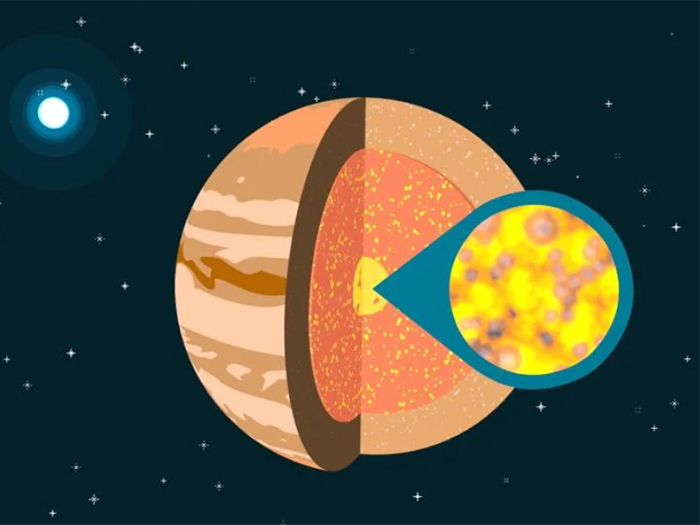Unraveling Warm Dense Matter:
From Simulations to Experiments
April 24, 2023
Researchers at LLNL and many other facilities are increasingly intrigued by warm dense matter (WDM), an extreme state between cold matter and hot plasma characterized by high temperatures, high pressures, and densities approaching and even partially exceeding solid objects.
These conditions occur in the interiors of giant planets, such as Jupiter, as well as in exoplanets; in brown dwarfs and white dwarf atmospheres; in neutron star crusts; and in the remnants of meteor impacts. WDM is also generated in the early stages of inertial confinement fusion (ICF) experiments.
 Warm dense matter is rare in the laboratory but common in the universe in places such as the hearts of giant planets like Jupiter. Credit: SLAC National Accelerator Laboratory
Warm dense matter is rare in the laboratory but common in the universe in places such as the hearts of giant planets like Jupiter. Credit: SLAC National Accelerator Laboratory LLNL’s interest in WDM dates back at least as far as 2002, when the Lab sponsored a workshop on “Extreme States of Materials: Warm Dense Matter to NIF.” In addition to astrophysics and ICF, high-temperature dense matter occurs in the regimes of interest to the science-based Stockpile Stewardship Program to maintain the reliability of the nation’s nuclear stockpile without underground testing. Obtaining a better understanding of WDM is important to performing effective stockpile stewardship experiments at NIF.
Reflecting this interest, LLNL physicists Tilo Döppner and Frank Graziani joined colleagues from institutions in Germany, Sweden, and the UK as co-authors of a recent Physics of Plasmas paper summarizing current WDM research. The paper appeared in a special edition of the journal describing current developments in the plasma field and was highlighted as an “Editor’s Pick.”
“We are witnessing the emergence of exciting new possibilities regarding the study of WDM,” Döppner said. “In light of the recent breakthroughs in fusion research here at NIF and elsewhere, the timing of these developments could hardly have been any better.”
“Warm dense matter research integrates challenging and exciting basic science with applications to real-world problems from astrophyiscs to ICF,” Graziani said. “Because of this work, it now opens the possibility that new tools such as quantum hydrodynamics can be made more accurate and applied to strongly coupled plasmas for longer length and time scales.”
Because of its relevance to astrophysics, ICF, and stockpile stewardship, WDM has been intensely studied at LLNL using x-ray Thomson scattering (XRTS), a powerful tool to probe the equation of state (EOS) of WDM and dense plasmas (see “Measuring Ionization at Extreme Densities”). Recent NIF Discovery Science campaigns have used XRTS to study brown dwarfs and to conduct high-precision ionization balance measurements in WDM. Experiments at LLNL’s Jupiter Laser Facility and at the OMEGA Laser facility at the University of Rochester have also used XRTS to study WDM.
Focus on Electron Density
“To advance both basic and applied research, the fundamental understanding of what WDM is and how it behaves in certain situations has to improve drastically,” the authors said. “A particularly important property for the understanding of WDM is given by its electronic density response to an external perturbation. Such response properties are probed in XRTS experiments and are central for the theoretical description of WDM.”
“The best approach to a complete understanding of WDM is to focus on its electronic density response,” said co-author Tobias Dornheim, junior group leader at the Helmholtz-Zentrum Dresden-Rossendorf (HZDR) institute Center for Advanced Systems Understanding (CASUS) in Germany. “People have been trying this for a long time—although with varying success. Our comprehensive review highlights both the successful advances and the encountered obstacles of this approach. It also includes many recent ideas and concepts that have been devised by the various authors of the paper.”
In general, both theory and experiment have substantially improved the capability to describe and measure characteristics of WDM from its electronic density response properties, yet it remains difficult to actually model experimental measurements, the authors said.
“In this article,” said co-author Jan Vorberger, a senior scientist from the Institute of Radiation physics at HZDR, “we bring together many different theoretical methods and show how they can help to create models that match the actual experimental observations. In addition to its direct use for astrophysical models, I am confident that this also has the potential to benefit developments related to inertial confinement fusion.”
The authors recommend several new experiments to test predictions by density functional theory and others from a novel perspective, as well as a closer collaboration of theorists and practitioners.
“Adapting experimental set-ups based on new conceptual ideas and simulation results will surely accelerate our gain in knowledge,” Dornheim said. “Written by theorists and experimentalists, our Physics of Plasmas article is emblematic of our desire to work closely together to advance WDM research.”
More Information:
“Electronic density response of warm dense matter,” Physics of Plasmas, March 15, 2023
“NIF Experiment Challenges Standard Ionization Models,” NIF & Photon Science News, July, 2016
—Charlie Osolin
Follow us on Twitter: @lasers_llnl



